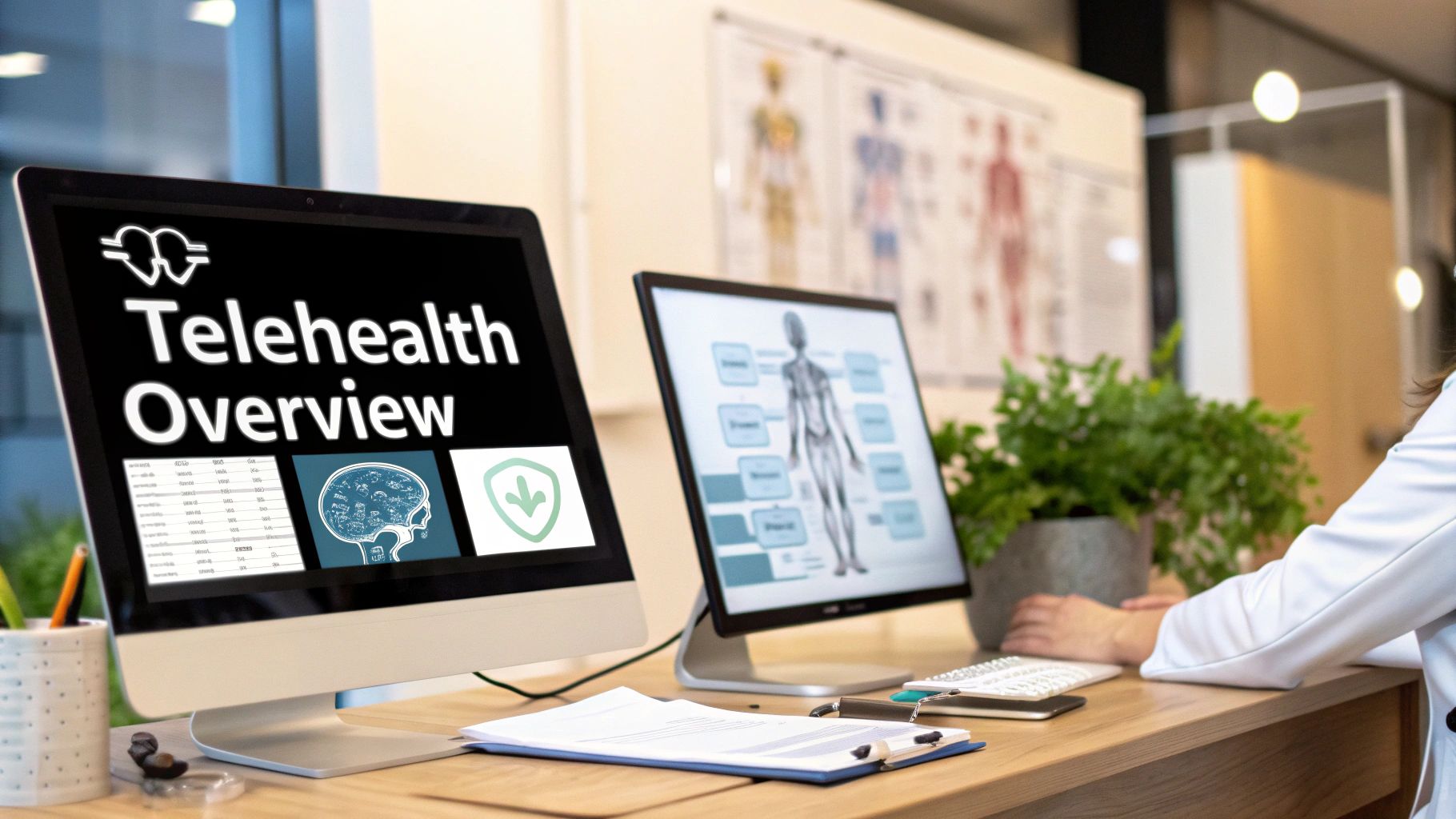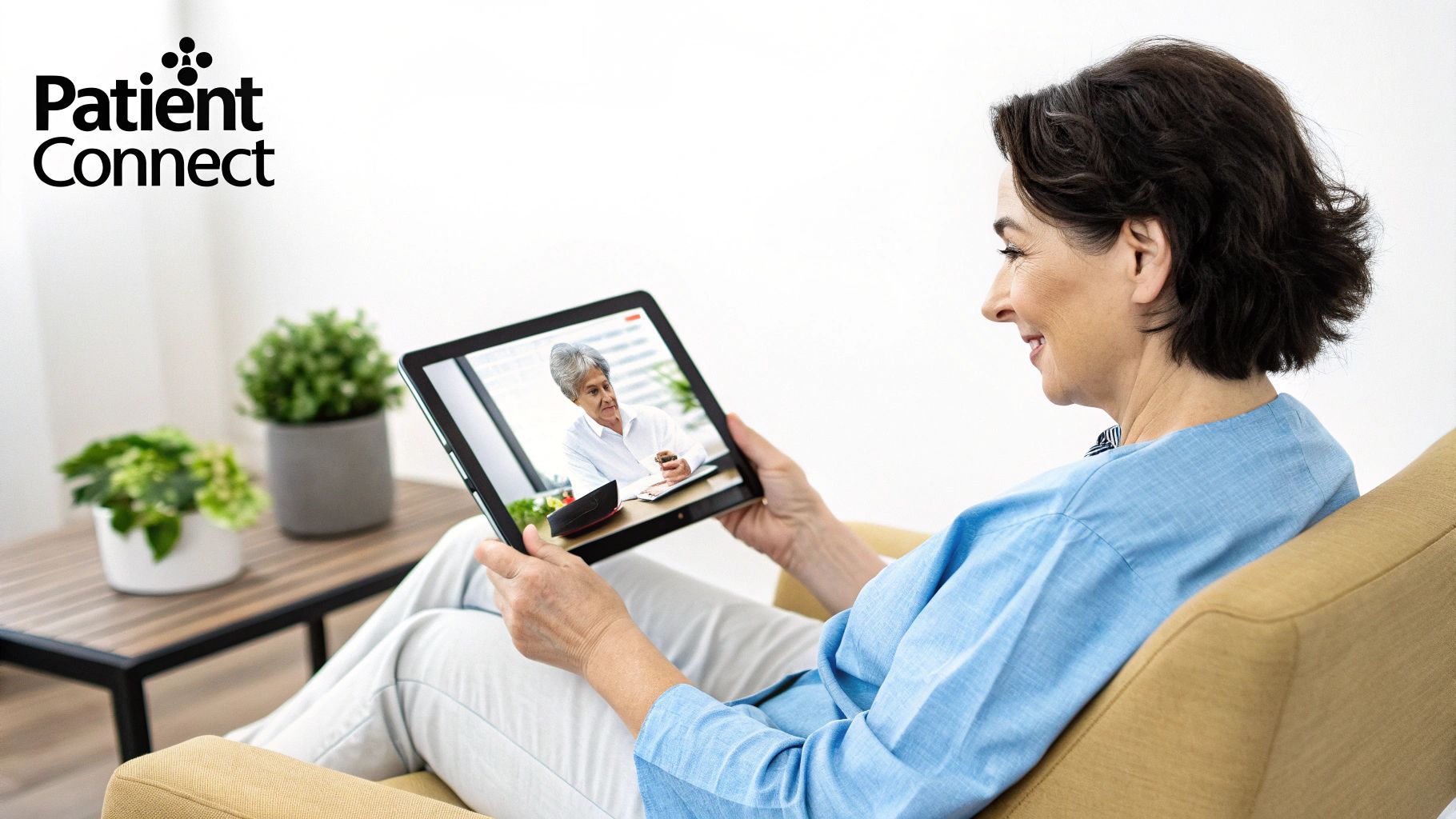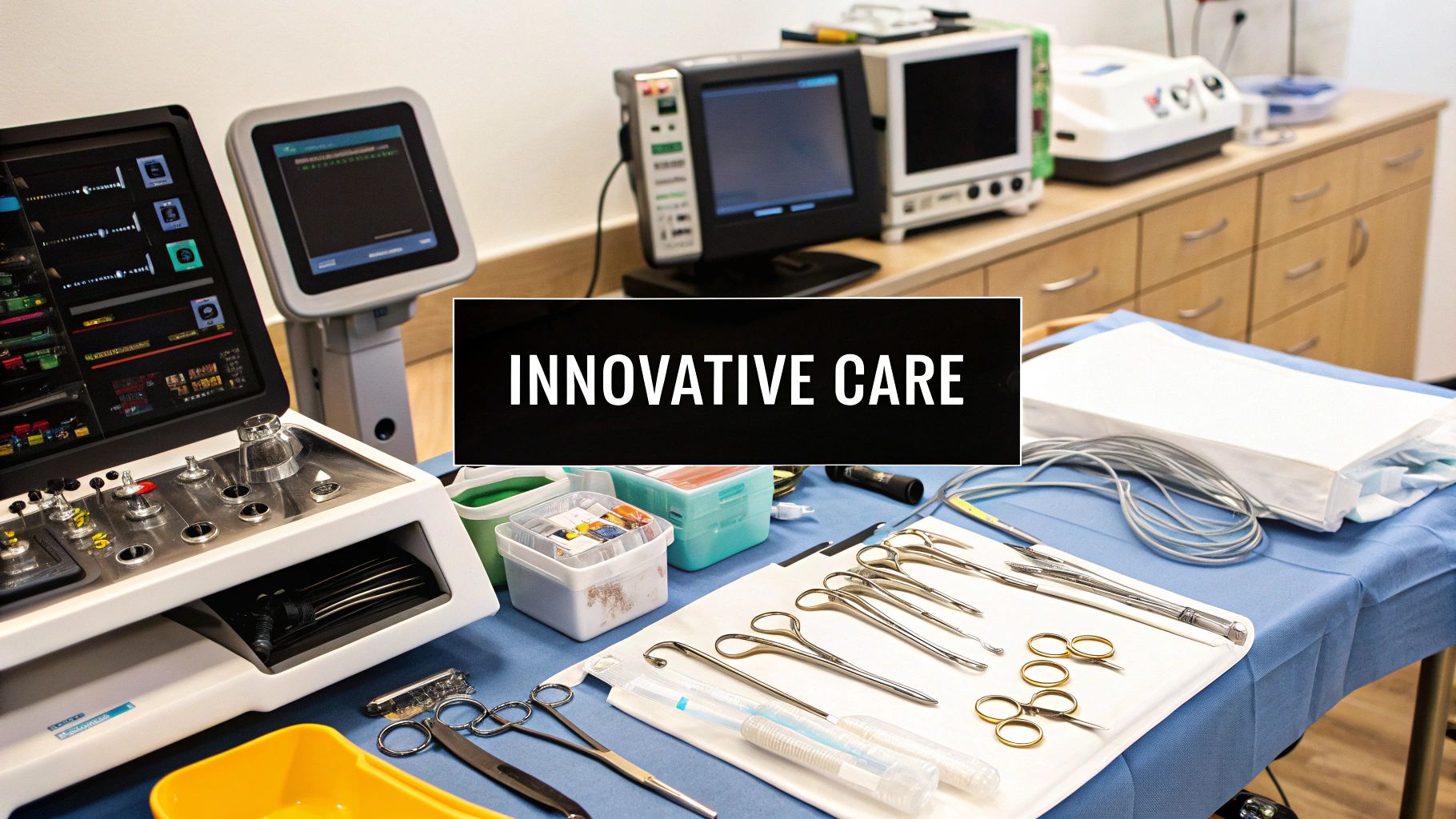The Evolution of Telehealth for Wound Care
Telehealth for wound care has evolved from a niche idea to a valuable tool in modern healthcare. This shift reflects a broader movement toward patient-centered care, fueled by technology and changing healthcare needs. Initially, the field relied heavily on store-and-forward systems. In these systems, images of wounds were sent to specialists for review. This asynchronous method offered a basic level of remote consultation. However, it lacked the immediacy and interactivity of in-person visits.
This early phase paved the way for more advanced telehealth solutions. The development of high-resolution digital cameras and secure video conferencing platforms enabled real-time consultations. Clinicians could interact directly with patients, visually assess wounds, and provide immediate feedback and treatment recommendations. This real-time interaction greatly enhanced the quality and effectiveness of remote wound care.
Key Advancements Driving Adoption
Several key advancements propelled telehealth for wound care into wider use. Widespread high-speed internet access allowed for seamless video communication and faster image transfer. Mobile devices with high-quality cameras made it easier for patients and caregivers to capture and share wound images. Changes in regulations and reimbursement policies legitimized and incentivized the use of telehealth for wound care.
These advancements coincided with growing research demonstrating telehealth’s effectiveness for certain wound types. Between 2007 and 2020, multinational trials revealed evolving telewound approaches. Austrian home nurses using store-and-forward telehealth achieved a 71% leg ulcer size reduction in 16 patients. A 2008 US study showed teleconsultations nearly halved IV antibiotic days (6.9 vs 13.3 days, p<0.001) for 48 rural patients with infected wounds. By 2024, digital health interventions demonstrated improved monitoring but inconsistent clinical outcomes. A systematic review noted moderate heterogeneity (I² metrics) across studies despite pooled healing benefits. These findings highlight telemedicine’s role in optimizing antibiotic stewardship and specialist access, especially for marginalized populations. Explore this further here. This accumulating evidence solidified telehealth as a viable and valuable option for managing wounds remotely.

Overcoming Challenges and Resistance
Despite these advancements, early telehealth adopters faced challenges. Some clinicians hesitated to embrace new technologies, questioning their effectiveness and reliability. Patients also had concerns about the security and privacy of their medical information. As technology improved and success stories emerged, these initial concerns gradually diminished. Today, telehealth for wound care is increasingly recognized as a valuable tool. It improves access to specialized care, reduces healthcare costs, and empowers patients to actively participate in their healing.
Clinical Efficacy: Does Remote Wound Care Actually Work?
Telehealth for wound care has gained a lot of attention lately. But does it really deliver? This is a critical question for both patients and providers. To find out, we need to look at the research comparing telehealth outcomes with traditional, in-person wound care.
Analyzing Outcomes: Healing Rates and More
A key measure of success in wound care is the healing rate. Research suggests telehealth can be just as effective as traditional care in this regard. A 2020 systematic review of 18 global studies found telehealth for wound care reduced unnecessary clinic visits without sacrificing effectiveness.
Pooled data revealed no significant difference in healing rates between telehealth and in-person care for chronic wounds. For instance, a Danish study of 40 home-care patients using bi-weekly web-based assessments saw comparable outcomes to standard care. A US trial with 120 diabetic foot ulcer patients also showed similar healing rates between weekly video consultations and wound center visits.
Furthermore, a meta-analysis of 229 chronic wound cases demonstrated a 50% higher likelihood of healing with telemedicine (RR 1.50, 95% CI 1.06-2.13, p=0.02). However, wound size reduction wasn't statistically different across the board. More detailed statistics can be found here. Beyond healing rates, telehealth also shows potential in other important areas like infection prevention and patient satisfaction.
To understand these differences further, let's look at a comparison table:
Telehealth vs. Traditional Wound Care Outcomes
Comparison of key clinical outcomes between telehealth and in-person wound care approaches based on multiple studies.
| Outcome Measure | Telehealth Results | Traditional Care Results | Statistical Significance |
|---|---|---|---|
| Healing Rate | Comparable to traditional care | Baseline comparison | No significant difference |
| Likelihood of Healing | 50% higher (RR 1.50) | Baseline comparison | p=0.02 |
| Wound Size Reduction | Not significant | Not significant | No significant difference |
| Clinic Visits | Reduced | Baseline comparison | Significant reduction |
| Patient Satisfaction | Generally higher | Baseline comparison | Varies by study |
This table highlights the comparable healing rates between telehealth and traditional care, while emphasizing the potential for telehealth to reduce clinic visits and improve patient satisfaction. However, more research is needed to determine the impact on wound size reduction.
Wound Types and Telehealth Suitability
Not all wounds are the same. Some, like chronic ulcers or surgical wounds, are well-suited for remote monitoring because of their predictable healing. A patient with a stable surgical wound, for example, might benefit from telehealth check-ins to watch for infection or complications, reducing the need for frequent office visits.
Other wounds, like complex or infected wounds, may require the hands-on care of traditional treatment. This is especially true when procedures like debridement or special dressings are needed. Careful patient assessment is vital when deciding on telehealth for wound care.
Real-World Experiences and Clinician Perspectives
As telehealth grows, it’s important to understand the changing landscape of medical documentation. More information is available in this article about The Evolution of Medical Documentation: From Paper to Digital. Clinicians with experience in both traditional and telehealth models offer valuable insights. Many report positive experiences with telehealth, especially regarding improved patient engagement and access to care.
However, they also stress the importance of clear communication and reliable technology for successful outcomes. These real-world experiences give a balanced view of telehealth’s strengths and weaknesses.

Bridging the Digital Divide in Wound Care
Telehealth offers incredible potential for wound care, but access to its benefits isn't universal. This raises a crucial question: who thrives with remote wound monitoring, and who faces obstacles? This section explores the demographic factors influencing engagement and outcomes in telehealth wound care.
Exploring the Impact of Demographics
Several demographic factors significantly affect a patient's experience with telehealth wound care. Age is a key factor, as older adults may have less experience with technology. Patients with limited technical comfort can also find digital interfaces challenging. Economic resources are another important consideration; access to reliable internet and smart devices is not a guarantee for everyone. Finally, geographic location influences access to broadband internet, essential for telehealth services.
For instance, a patient in a rural area with limited internet access may struggle with video consultations. A tech-savvy younger patient in an urban setting, on the other hand, might find the technology easy to use. These diverse scenarios highlight the importance of addressing the digital divide in telehealth.
Identifying and Supporting At-Risk Patients
Successful telehealth programs proactively identify and support patients at risk of disengaging. This may involve assessing patients' tech literacy and offering training. Alternative communication methods, like phone calls, can be provided for those uncomfortable with video platforms. It can also involve providing loaner devices or helping patients find affordable internet access.
Furthermore, healthcare providers can simplify technology interfaces. Using larger fonts and intuitive navigation can significantly improve usability, especially for older adults or those with visual impairments.
Overcoming Barriers Through Innovation
Innovative programs are developing creative solutions to make telehealth more inclusive. Some programs offer remote tech support to help patients troubleshoot any issues they encounter. Others pair older adults with younger family members to assist with the technology, bridging generations and increasing patient comfort. Multilingual support is another strategy used to address language barriers.
In Singapore, a 2022 study on telewound monitoring highlighted these demographic differences. The study, analyzing 135 primary care patients with acute wounds, revealed that younger patients and those requiring faster healing times used telehealth more frequently. The average patient age was 27.9 years, with an average wound size of 7.8 cm² and a healing duration of 11.7 days. Despite similar wound sizes, older patients had fewer telehealth sessions. Their predictive model, explaining 15.7% of the variance, connected increased age (p=0.043) and longer healing times (p=0.043) to reduced telemedicine use. This underscores the demographic disparities in telehealth adoption, even in technologically advanced healthcare systems. Read the full research here. These findings emphasize the importance of culturally sensitive telehealth design and implementation.

These strategies help ensure telehealth benefits all patients, regardless of background or technological proficiency. This thoughtful, inclusive approach is essential for maximizing the potential of telehealth for wound care and achieving equitable access to quality healthcare.
Building a Telehealth Wound Care Program That Lasts
Building a successful telehealth program for wound care requires more than just buying new technology. It takes careful planning and execution to build a sustainable system that benefits both patients and providers. This includes addressing key areas like choosing the right technology, training staff, budgeting, and ensuring quality care.
Selecting the Right Technology Stack
Choosing the right technology is crucial. The best technology should integrate seamlessly with current workflows. Think of it like adding a new room to your house – it should blend with the existing structure. The technology should be user-friendly for both patients and staff. A complicated interface can lead to frustration and prevent people from using it. Secure data storage and transmission are also essential for patient privacy and complying with regulations like HIPAA.
Effective Staff Training and Buy-In
Even the best technology is ineffective without well-trained staff. Training should cover not only how to use the technology but also how to adapt clinical workflows for remote care. It’s important to address staff concerns and resistance to change. Some staff may be hesitant about new technologies, so it’s key to highlight the benefits for both patients and providers. This might include showing how telehealth can improve efficiency, expand patient access, and even decrease workload.
Realistic Budget Considerations and Reimbursement
Telehealth programs have costs beyond the initial technology purchase. Ongoing maintenance, software updates, and technical support need to be included in the budget. Ensuring these resources are available to all patients is vital, including making information readily available such as how to make PDF accessible to address the digital divide. Understanding reimbursement pathways is also critical for financial stability. Researching how different payers reimburse for telehealth services and improving billing processes can help maximize revenue.
Maintaining Quality and Clinical Standards
Quality assurance is essential for any healthcare program, and telehealth is no exception. Establish clear clinical protocols and guidelines for remote wound assessment and treatment. Regularly review patient outcomes and program performance to find areas for improvement. This ensures consistent, high-quality care that is comparable to in-person visits.
To help guide implementation, the following checklist outlines key components and considerations:
Telehealth for Wound Care Implementation Checklist
| Implementation Component | Key Considerations | Common Challenges | Success Strategies |
|---|---|---|---|
| Technology Selection | Integration with existing workflows, user-friendliness, security, data storage | Cost, compatibility issues, staff resistance to new technology | Thorough needs assessment, pilot testing, vendor selection based on specific needs |
| Staff Training | Comprehensive training on technology use and adapted workflows, addressing staff concerns | Lack of time for training, staff buy-in, technical proficiency | Hands-on training, ongoing support, clear communication about benefits |
| Budgeting | Initial investment, ongoing maintenance, software updates, technical support, reimbursement pathways | Unexpected costs, difficulty securing funding | Detailed budget planning, exploration of funding opportunities, cost-benefit analysis |
| Quality Assurance | Clinical protocols, outcome tracking, performance review, patient satisfaction | Maintaining consistency of care, remote monitoring challenges, data collection | Regular audits, standardized procedures, patient feedback mechanisms |
This checklist serves as a starting point for building a robust and effective telehealth wound care program. By addressing these components, providers can ensure successful implementation and long-term sustainability.
Overcoming Implementation Pitfalls
Implementing a new program always has challenges. One common pitfall is inadequate planning, which can lead to unexpected technical problems or workflow disruptions. Another is poor communication between team members, which can hinder coordination and create confusion. Successful programs address these challenges by including all stakeholders in the planning process, promoting open communication, and proactively identifying potential issues. They also remain flexible and willing to adjust their approach as needed. For example, some programs found they needed to offer more tech support to patients at the beginning to ensure a smooth onboarding process.

Building a Program for the Long Term
By addressing these key areas, healthcare providers can build telehealth wound care programs that are not only effective but also sustainable. This involves creating a program that integrates smoothly into current operations, provides consistent value to patients, and adapts to changing needs and technologies. The ultimate goal is to improve patient outcomes and access to care, making telehealth a valuable and lasting part of the healthcare system.
Choosing the Right Tools for Remote Wound Assessment
Technology for telehealth wound care is constantly evolving. This section offers a practical guide to the tools clinicians are using, comparing approaches and examining the challenges of implementing them.
Synchronous vs. Asynchronous Approaches
There are two primary methods for conducting telehealth wound care: synchronous and asynchronous. Synchronous telehealth, like a video call, occurs in real time. This provides immediate interaction between patient and clinician, which is essential for time-sensitive situations. Think of assessing a quickly changing wound or giving real-time feedback on bandaging techniques.
Asynchronous telehealth uses stored information, like photos of a wound sent for later review. This is ideal for routine monitoring of stable wounds where immediate interaction isn't critical. It offers flexibility for patients who don't require instant feedback.
Imaging Technologies: Balancing Accuracy and Usability
Selecting the right imaging technology is vital for any telehealth wound care program. High-resolution images are crucial for accurate assessment. But the technology must also be easy to use for both patients and clinicians. A complex system can lead to errors and frustration, hindering effective remote monitoring.
Some programs successfully use smartphone cameras with specialized apps like WoundZoom. These apps guide image capture, ensuring consistent quality.
Integration Challenges and Solutions
Integrating telehealth tools with existing systems can be a major obstacle. Many healthcare providers use Electronic Health Records (EHRs) and other software that need to work smoothly with new telehealth platforms. If these systems don't communicate effectively, it can create extra work and increase the risk of errors.
Successful programs prioritize interoperability when choosing telehealth tools. This ensures smooth data flow and reduces administrative overhead.
Real-World Implementation Stories
Learning from real-world examples is invaluable. One program improved image quality by providing patients with clear instructions for taking wound photos. Another program boosted staff adoption by offering training sessions on the new telehealth platform.
These practical insights demonstrate the importance of addressing both patient and provider needs during implementation. By understanding these examples, organizations can better navigate the balance between advanced technology and ease of use for everyone involved.
The Future of Telehealth for Wound Care
Telehealth is transforming wound care, offering exciting new options for remote wound management. Emerging technologies are changing how we assess, monitor, and treat wounds, resulting in more effective and accessible care.
Artificial Intelligence: Transforming Wound Assessment
Artificial intelligence (AI) is rapidly changing many fields, including wound care. AI algorithms can analyze images of wounds to identify infection, predict healing progress, and even suggest the best treatment plans. This technology can significantly improve the accuracy and speed of wound assessments, particularly in areas with limited access to specialists. Imagine an app analyzing a photo of a wound and instantly providing feedback on its severity. This empowers patients to get timely care and helps clinicians make faster, more informed decisions.
Wearable Sensors: Constant Wound Monitoring
Wearable sensors are another exciting development in telehealth wound care. These sensors can continuously monitor wound factors like temperature, moisture, and pressure. This constant data flow can provide early warnings of issues such as infection or slow healing. Imagine a smart bandage that tracks the healing process and alerts the clinician if a problem arises. This constant monitoring can significantly improve how we manage chronic wounds, enabling faster intervention and better patient outcomes.
Advanced Imaging: A Deeper Look
New imaging technologies, such as hyperspectral imaging, offer a deeper understanding of wounds. These technologies capture information beyond what's visible, providing detailed views of tissue health and blood flow. This comprehensive perspective improves diagnostic accuracy and allows for more personalized treatment plans. Imagine seeing the blood flow around a wound without a complex medical scan. This technology could help clinicians identify potential problems early, leading to better treatment outcomes.
Virtual Reality Training: Bridging the Skills Gap
Virtual Reality (VR) technology creates immersive training simulations for wound care. These simulations allow clinicians to practice complex procedures and develop skills in a safe environment. This innovative approach can address the growing skills gap in wound care and ensure clinicians access high-quality training. For example, a VR simulation lets a nurse practice changing a complex dressing many times before performing the procedure on a patient. This increases confidence and reduces errors.
Overcoming Challenges and Embracing the Future
While the future of telehealth for wound care is promising, challenges remain. Data security and patient privacy are critical, and regulations are still developing. As technology advances, we can expect these limitations to be addressed. Clinicians can prepare for the future by staying updated on telehealth developments and supporting policies that encourage innovation and access to care.
By embracing these emerging technologies, telehealth can transform wound care, benefiting both patients and clinicians. These advancements offer more accurate assessments, ongoing monitoring, and personalized treatment, making high-quality wound care accessible to everyone, regardless of location.
Ready to experience the future of wound care? Learn more about Rapid Wound Care and our innovative approaches to comprehensive, at-home wound care services.

